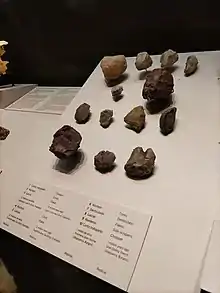Barranco León
Barranco León is an archaeological site in Orce, Andalusia, Spain with an age range between 1.2 and 1.4 million of years.[1] It is noted for having yielded evidence of hominin occupation, including the milk tooth of a boy or girl of 10 years. After the tooth had been dated, its original owner (the "child of Orce") was hailed as having left the earliest anatomical evidence for humans in Western Europe.[2][3]
 | |
| Location | Orce |
|---|---|
| Region | Province of Granada |
| Coordinates | 37°43′26.5620″N 02°27′02.8230″W |
| Type | Archaeological site |
| History | |
| Periods | Pleistocene |
| Cultures | Oldowan |
| Site notes | |
| Excavation dates |
|
| Archaeologists |
|
The site was excavated in 1995 by Josep Gibert i Clols and between 1999 and 2000 by Martínez Fernández y Toro.
Animals
Now situated in an arid area of Spain, the site was once at the edge of a lake. Among the large mammals were found Hippopotamus antiquus, Equus altidens, Felidae cf. Homotherium sp., Megaloceros sp. and Bovini gen. et indet.[4]
Humans
Apart from the tooth, other finds from Orce have been posited as early human remains, but their status has not been confirmed.
Stone Tools

The lithic industry assemblage found at the site is from the Oldowan,[4] and consists of more than 1000 artefacts (including waste flakes). Spiral or helical fractures, impact points, flake scars, and bone flakes were discovered on megafaunal remains and are associated with the tools.[2]
See also
The Instituto Geológico y Minero de España in collaboration with the Spanish Geological Society (Sociedad Geológica de España) has drawn up a list of internationally important geosites in Spain. These geosites are known in Spain as LIGs. Barraco Leon is listed as AND331,[5] a separate reference from the global geosite one, VP016. The listing is primarily for the site's paleontological interest with regard to vertebrates ("Yacimientos de vertebrados del Plioceno y Pleistoceno españoles"), although the stratigraphy is also of interest. It is noted that the exact location of the site is confidential.[5]
The geosite is one of 72 included in the Granada Geopark. The Geopark was included in the European Geoparks Network in 2020.[6] The Geopark has promoted Orce in the context of geotourism as being on a trekking route, the "First Settlers Great Path", which starts and finishes at Huéscar.[7]
References
- Casado Rodríguez, Aroa (2015). Grado en arqueología. Estudio de la distribución espacial del yacimiento arqueológico de Barranco León (Orce, Granada) (PDF) (in Spanish). Universidad de Barcelona. p. 9. Retrieved 24 January 2019.
- Toro-Moyano, I.; Martínez-Navarro, B.; Agustí, J.; Souday, C.; Bermúdez; de Castro, J.M.; Martinón-Torres, M.; Fajardo, B.; Duval, M.; Falguères, C.; Oms, O.; Parés, J.M.; Anadón, P.; Julià, R.; García-Aguilar, J.M.; Moigne, A.M.; Espigares, M.P.; Ros-Montoya, S.; Palmqvist, P. (2013). "The oldest human fossil in Europe, from Orce (Spain)". Journal of Human Evolution. 65 (1): 1–9. doi:10.1016/j.jhevol.2013.01.012. hdl:10261/84112. PMID 23481345.
- "Barranco León: Yacimiento Paleontológico". Portal de la comarca de Huescar (in Spanish). 2009. Retrieved 23 January 2019.
- Toro Moyano, Isidro; Agustí i Ballester, Jordi; Turq, Alain; Martínez Navarro, Bienvenido; Oriol Oms Llobet, Josep (2000). "Los yacimientos del Pleistoceno inferior de Barranco León y Fuente Nueva 3 de Orce (Granada). Contribución al conocimiento del primer poblamiento humano de Europa". SPAL: Revista de Prehistoria y Arqueología de la Universidad de Sevilla. 9 (9): 179–188. doi:10.12795/spal.2000.i9.09. ISSN 1133-4525.
- "AND331:Yacimiento paleontológico de Barranco León-5". Instituto Geológico y Minero de España (IGME) (in Spanish). Retrieved 24 January 2019.
- "UNESCO designates 15 new Geoparks in Asia, Europe, and Latin America". Retrieved 2023-08-08.
- "First settlers great path". Retrieved 2023-08-08.